
A cost overrun is the sum of unpredicted expenses that exceeds initial budget estimates at any point throughout the course of project realization.
Cost overruns can be dangerous to project success since they imply that, to maintain project activities, a firm has to spend funds intended for entirely other purposes at first. In the context of financial constraints, unexpected expenses may also provoke the growth of the organizational dept. Hence, it is pivotal to understand the reasons why cost overruns occur and address them accordingly.
In light of this, we have prepared a guide explaining how to prevent and calculate cost overruns.
What Is a Cost Overrun?
A cost overrun (or a budget overrun) indicates the amount of expenses that exceed your estimated project costs. The discrepancy between the desired or estimated outcomes and the actual ones is what a cost overrun measures.
To identify and calculate a cost overrun, you can use the following two simple formulas:
Factors Increasing the Risk of Cost Overruns
Project managers should know how to spot cost overruns early on. Here are some signs that your project is at risk of cost overrun:
- You don’t have a time and cost tracking system in place.
- The project budget is not specified.
- No contingency plan is developed and documented.
- You don’t schedule and track project resources.
- You don’t track costs for each task (at least with a work breakdown structure).
- You have never reviewed and learned from the previous projects’ performance.
5 Primary Causes of Cost Overruns + Ways to Avoid Them
1. Improper risk and uncertainty management
Troublefree completion of project activities by following a designed plan is a cherished desire of every result-oriented manager. However, this perfection isn’t that easy to attain – deep business waters are swarmed by all sorts of risks, which are often very easy to stumble upon but are difficult to cope with. Besides, in an environment that evolves apace and spawns new trends each month (if not more often), it becomes incredibly challenging to predict the outcomes of scheduled events.
Therefore, without careful environmental analysis and a risk response strategy, all project designs and approaches to management are bound to fail, regardless of how thoughtful and elaborate they may be. An unpredicted risk – either internal or external – may cause a direct financial loss and require unexpected expenses for its handling. When this risk is significant and damaging enough, cost overrun is inevitable.
Solution:
The best way to reduce the adverse impacts of environmental risks and uncertainty is the adoption of a valid risk management system that incorporates the following components:
Comprehensive risk analysis allows the identification of the most probable and relevant external risks.
Risk mitigation and response plans focus on the strengthening of weak areas in the company’s internal factors and increasing its adaptiveness to external changes.
Contingency reserve development aims to allocate a justified amount of money for the reduction of possible risk overruns.
Of course, managers cannot influence such potentially impactful external events as natural disasters and economic recession directly. Nevertheless, both internal and external risks must be paid equal attention during risk management. In this way, unexpected expenses will be less likely to occur and put the project’s success on the line.
Implementation scenario:
Home Ltd. is a mid-sized real-estate construction firm that worked on a high-profile project two years ago – it had to build a modern office complex in a rapidly developing metropolitan area. Although the project started on a strong note, it went through a series of costly challenges that were not anticipated during the initial planning phase:
At first, inadequate soil testing revealed unforeseen subsoil conditions, so the company invested in expensive piling work without any actual necessity. Then, a key supplier suddenly went bankrupt in the midst of the project. As a result, the supply of critical materials was delayed for weeks. On top of that, the management failed to foresee seasonal monsoon rains, which caused massive waterlogging and equipment damage.
Together, these factors led to a 40% cost overrun and a 5-month schedule delay, which harmed Home Ltd.‘s reputation tremendously.
Now, to carry out a new important project and deliver it without any significant loss, the company is determined to avoid its past mistakes. Thus, it undertakes a serious approach to risk management:
Step 1: The firm establishes a risk management team made up of engineers, project managers, legal advisors, and environmental specialists. They collaborate to identify all the potential risks, including poor site conditions, labor issues, regulatory hurdles, and weather-related challenges. They use the lessons learned from the previous project and decide to carry out advanced geotechnical studies (to minimize the risk of subsoil issues and unexpected costs they may entail).
Step 2: The team applies advanced simulation software to run a plethora of “what-if” scenarios, comprehend the impact of potential risks, and prepare targeted mitigation strategies.
Step 3: To mitigate supply chain risks, Home Ltd. diversifies its supplier base and signs contracts with backup suppliers.
Step 4: Equipment and materials are now selected with resistance to inclement weather in mind + construction schedules are adjusted to account for expected monsoons.
Step 5: The team reserves a contingency fund of 15% of the project cost in order to handle unexpected challenges.
Step 6: The firm adopts actiTIME to track the use of resources in real time. Using its budget tracking functionality, the company’s project managers allocate cost and time budgets for every single task within the project + set the billing budget for the entire scope of work. Then, they monitor the ongoing use of resources every single day via visual progress bars. This way, they become capable of identifying even the tiniest cost and schedule overruns promptly and responding to them without delay.
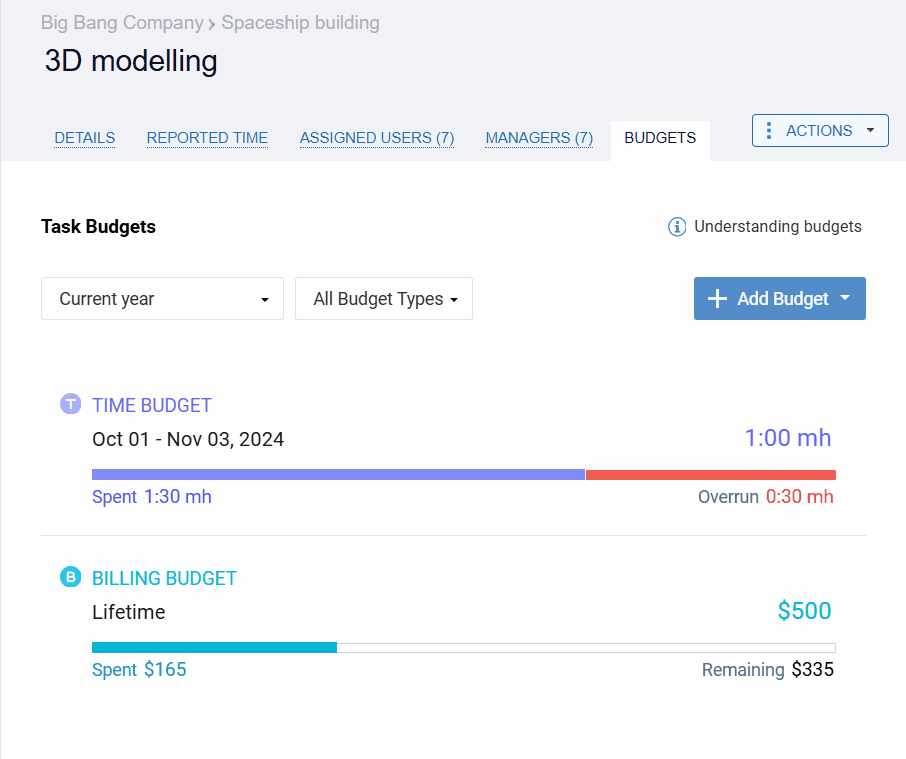
With these measures, Home Ltd. is properly equipped to handle unforeseen challenges in its new project. The company expects to reduce cost overruns by 20%, complete all the planned works within the agreed timeline, recover its reputation from past failures, and strengthen clients’ trust in its ability to deliver large-scale projects as planned.
Get free risk assessment templates here 👈
2. Estimation and budgeting errors
Underestimation of future costs (or the making of overly optimistic estimates) is the primary cause of project overruns in a vast majority of cases. The main reason why estimation errors take place is forecasting biases, either intentional or unintentional. As noted by Condon and Hartman in their “Playing the Game” paper, these biases can be a consequence of:
Naivety – belief that everything will go as planned.
Ignorance – lack of necessary knowledge and expertise.
Deception – deliberate misrepresentation of the project’s expense picture to make it look viable.
It means that underestimation frequently occurs due to sponsors’ and managers’ eagerness to see their project ideas being brought to life. Those without prior experience in project management face an even higher risk of cost overruns. Inexperienced managers have nothing to compare their current undertakings with and, thus, are prone to make mistakes and miss some essential risk factors out of consideration.
Solution:
To avoid cost overruns, aim to improve your cost estimators’ competencies and skills and increase accountability for forecast inaccuracies within your projects.
More specifically, it would help to allocate estimation responsibilities to experienced specialists as a means to increase rigor and decrease the influence of “gut instinct” on forecasting results; encourage inter-professional collaboration among various stakeholders during the estimation phase; determine who would have to carry cost overruns if they take place; and scrutinize and evaluate the created cost estimates multiple times.
All in all, by taking time and effort to make initial cost calculation more precise and evidence-based, it is feasible to make sure that the project won’t surpass the estimated budget and that its outcomes will be positive.
Implementation scenario:
James runs a small digital marketing agency and plans out a new campaign for a long-time client. He had successfully delivered similar projects to the same client in the past. Thus, he decides to implement estimation by analogy to predict how much money and time is required to complete the new campaign without budget overruns.
Step 1: James applies actiTIME reports to analyze resources invested in the previous project for the client. He opens the Estimated vs. Actual Time Report first to identify any discrepancies in terms of the use of time throughout the course of work. Then, he runs the Cost of Work Report to analyze staff-related expenses by every single task.
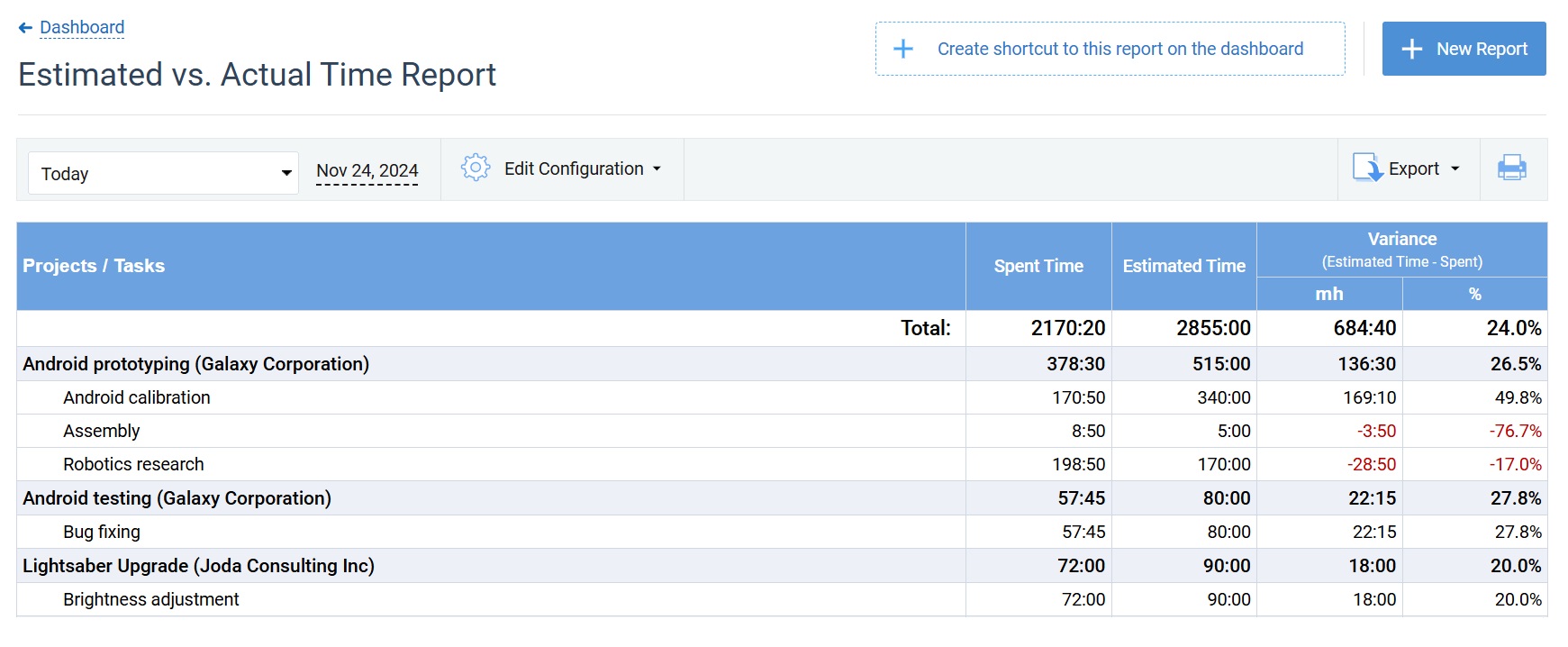
Step 2: James conducts the budget variance analysis using historical data to make sure his initial estimates matched the actual results of the completed projects. If some task estimates were not met in the past, he digs deeper to comprehend what went wrong and adds some buffer time and money for the new similar task.
For instance, one task incurred slightly more expenses than he expected initially because an employee stayed overtime to complete it. Therefore, he now makes certain to set a larger time estimate for that task (and a looser deadline) so the employee doesn’t have to stay up late to make it done and James doesn’t have to pay them extra.
Step 3: James uses his analysis results to set estimates for the new project. He allocates cost and time budgets to every task in actiTIME + adds the overall cost and billing budget to the entire project. He also makes sure to set pay rates for every employee and billing rates for each task – this way, actiTIME can automatically calculate the use of resources per hour of work, while James can easily monitor ongoing progress and identify the risks of budget overruns promptly with the help of the visual budget trackers:
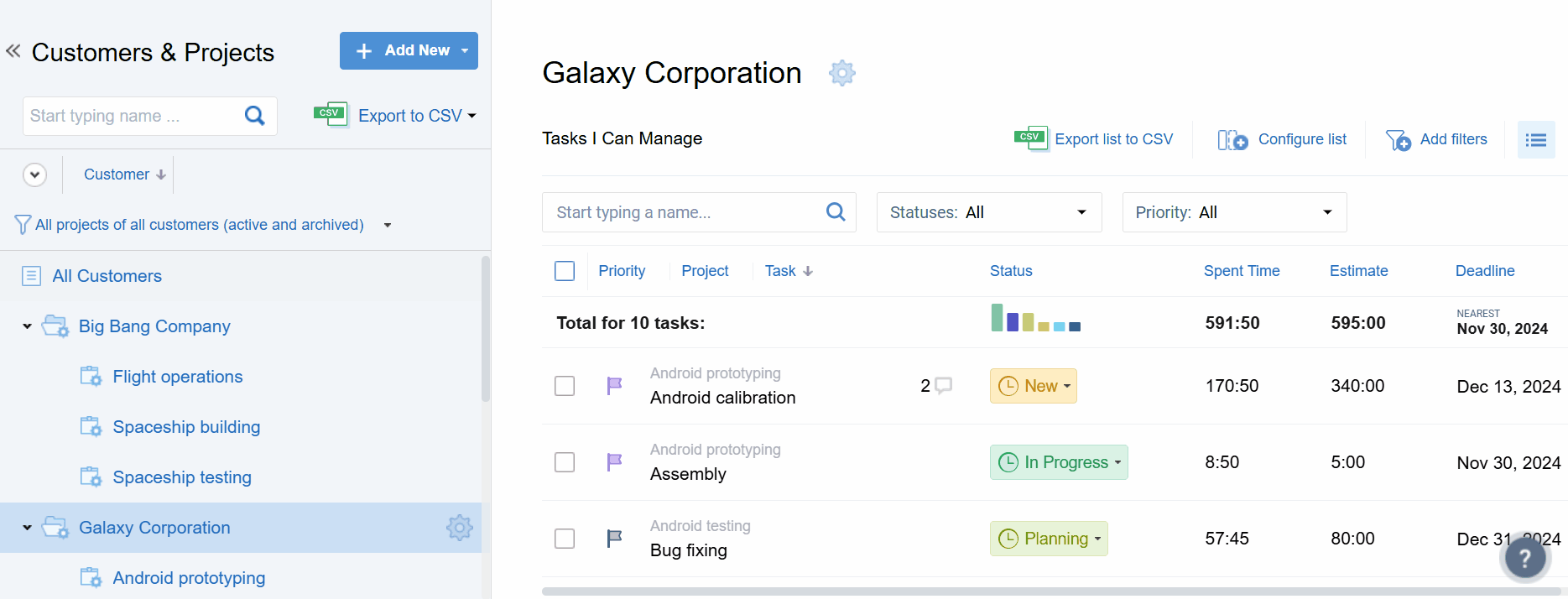
The analogous estimation technique helped James to correct his previous budgeting and scheduling mistakes and deliver the new campaign with better financial results. Thus, he decided to use historical data as a starting point in the estimation of all his future projects, even those that differ from each other a lot.
Get free budget tracking templates here 👈
3. Uncontrolled scope changes
Since the business environment is highly dynamic and rarely develops according to our plans, changes in projects and their scopes are usually hard to get away from. The unchecked growth of the project’s scope, also known as scope creep, is a massive problem for project managers, and it happens on the following occasions:
Underestimated project complexity
If a manager lacks an understanding of the project’s nuances and is unable to predict its complexity, the risk of improper allocation of resources increases.
Imagine learning that your team must do much more than was expected to achieve formulated project goals only after the actual work begins. In this case, you will likely have to establish new deadlines and re-coordinate activities, personnel, and technologies. Therefore, the need for additional expenses will arise as well.
Schedule extension
The misunderstanding of project content and nature is only one possible cause of deadline extension. Others include changing project requirements, delays in the supply of essential materials, the dismissal of important employees, and many more external and internal events, both planned and unforeseen.
As such, a prolonged project schedule can be regarded as the primary sign of scope creep. It induces cost overruns as much as the handling of issues that called it forth requires extra effort and funds.
Poor stakeholder communication
Improper communication and disagreeable relations between parties involved in the project’s realization end in the absence of clarity regarding project objectives, requirements, and progress.
For instance, if employees engaged in the project do not fully comprehend its objectives and task approval parameters, they will tend to make mistakes. In turn, managers and sponsors will become dissatisfied with the performance results and will have to demand revisions and corrections from their subordinates.
Clearly, it is much cheaper to make things properly straight away than to remake them multiple times. Hence, inadequate stakeholder communication may give rise to not only scope creep but also large-scale cost overruns.
Solution:
The success of the project in the context of constant change depends on how controlled that change is. Therefore, to prevent scope creep and consequent cost overruns, Agile Certified Practitioner, Chuck Millhollan recommends implementing a change control strategy that includes the following:
The design of lean project workflows in order to be more adaptive to alterations in the environment and keep away unnecessary complexities in the course of work.
The definition of preliminary project scope, as well as the development and approval of scope documentation, to set more explicit boundaries and make more reasonable project change decisions;
The application of a systematic approach to stakeholder communication that would integrate well-structured methods for requesting, evaluation, and approval of project changes.
Implementation example:
No matter what kind of projects you manage, actiTIME allows you to plan out your entire scope of work in detail:
Step 1: Create a client or a project and add as many tasks to it as you please. Then, you can set time estimates, deadlines and priorities for tasks, write comments and attach any project-related documents to them, if needed. It’s also possible to create custom fields for tasks and allocate cost, time, and billing budgets for them.
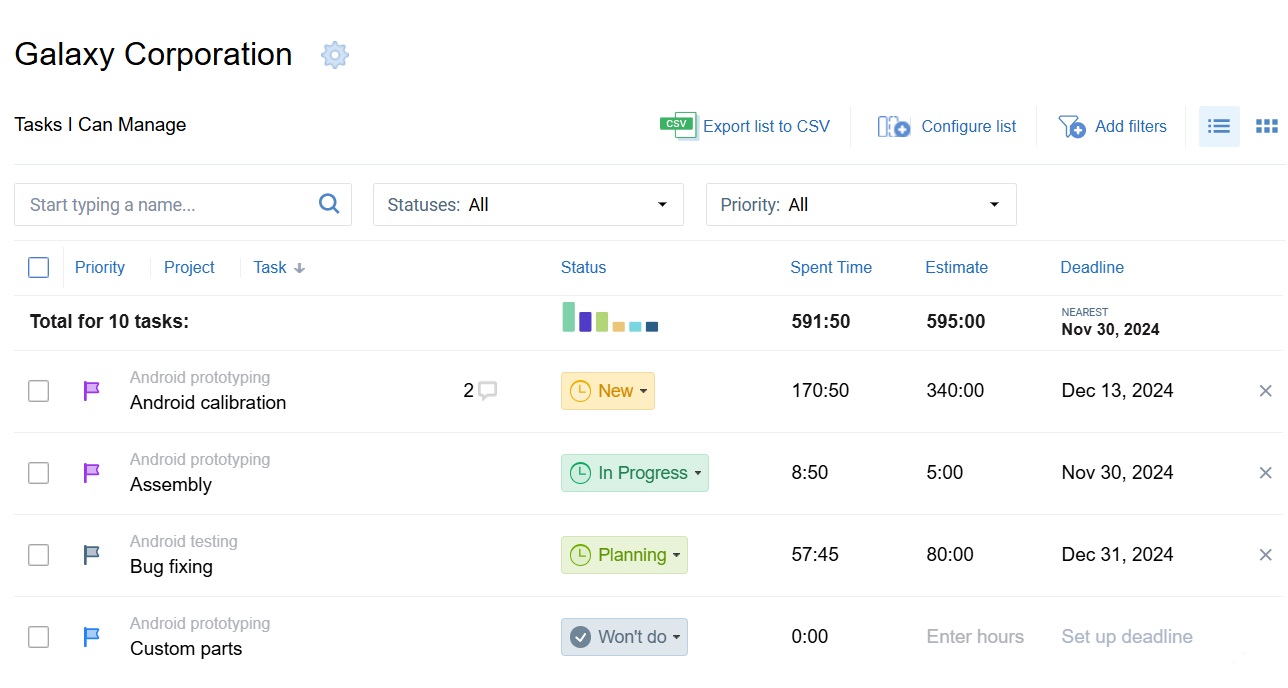
Step 2: Allocate the created tasks to employees and create your custom workflows (aka task statuses) to be able to track task progress from the start of the project till its end. Make sure to keep those workflows as lean as possible. So, don’t include any unessesary steps in them to avoid bottlenecks and delays.
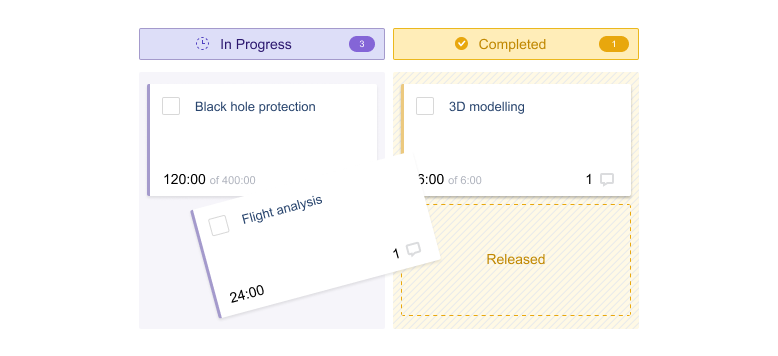
Step 3: Start tracking time, costs, and work progress in actiTIME – it will help you identify any risks of scope creep, project delays, or cost overruns and quickly address them.
Get free work breakdown template here 👈
4. Project performance failures
Small mistakes and fatal errors during the execution of project activities can occur due to multiple reasons, such as poor resource coordination, lack of essential skills and technology, inadequate employee motivation and communication, ineffective project execution plan, or the absence of clearly defined operational metrics that could be used to standardize and evaluate employee / contractor performance.
Naturally, when something in the project goes wrong, managers have to invest time, money and effort to direct it back on the right track. In this way, big execution mistakes induce a significant risk of surpassing the estimated budget.
Solution:
Elimination of causes for the abovementioned performance failures is the primary responsibility of project managers and leaders. Thus, to avoid the risk of cost overruns due to execution errors, a well-organized approach to leadership and project management is obligatory.
Overall, for faultless work on the project, managers and leaders should systematically control EVERY project performance factor, starting from the hiring of skilled personnel and ending with the selection of appropriate progress assessment tools. For the latter, assume applying a piece of project management software that allows planning workflows, distributing workloads, and supervising employee task performance all in one place. With its assistance, the administration of project management will become much simpler and more efficient.
Implementation example:
As a multifunctional project management solution, actiTIME can help you keep work performance under 100% control.
Step 1: Assign different user roles to employees to enable managers to supervise others’ work and analyze productivity of their entire assigned teams.
Step 2: Instruct your team members to track working time every single day. For those who don’t feel like making time entries in their timesheets manually, actiTIME offers one-click timers in the mobile app and a fully automated browser extension that is perfect for employees working online.

Step 3: Monitor ongoing work progress using a variety of methods: the Kanban board, visual estimate and budget trackers, overtime reports, project cost charts, and much more.
With actiTIME, not a single project execution problem remains unnoticed!
Sign up for a free 30-day trial here 👈
5. Errors in project design
Project design forms the basis for the execution and management processes. It specifies which contents the project must have, how it should be performed and supervised + what kind of outputs it is expected to produce.
Obviously, with flawed project design, it is naïve to anticipate positive project outcomes – even the most unnoticeable and presumably uncritical deficiencies in the initial plan are likely to be manifested at the later stages in the project’s life cycle, leading to performance failures and other problems provoking unforeseen expenses and jeopardizing project success.
Solution:
As it is easy to guess, an antidote to cost overruns due to poor project planning is the creation of a proper, comprehensive project design. Besides scope definition, time estimates, communication, and risk management strategies that we have discussed before in this article, a perfect project plan contains the following key elements:
- Idea justification.
- List of stakeholders and their needs.
- Outline of project objectives, requirements, and deliverables.
- Definition of roles and responsibilities.
- Resource allocation targets.
- Description of quality assessment methods.
Most importantly, it is vital to conduct a detailed cost breakdown and develop an accurate project budget. These two practices are the core elements of effective project cost management and a significant prerequisite for successful expense control throughout project realization.
Get free project cost breakdown templates here 👈
Summary
Summing up our overview of the five leading causes of cost overruns, let’s recall them once more. The list consists of:
- Inadequate risk management.
- Underestimation of project costs.
- Uncontrolled scope changes.
- Project execution failures.
- Errors in project design.
To prevent unnecessary waste of money when fixing mistakes and achieve the desired project outcomes, address the above issues promptly. Be sure to utilize the discussed solutions – they will be of significant aid in evading risks and enhancing performance efficacy.


















































